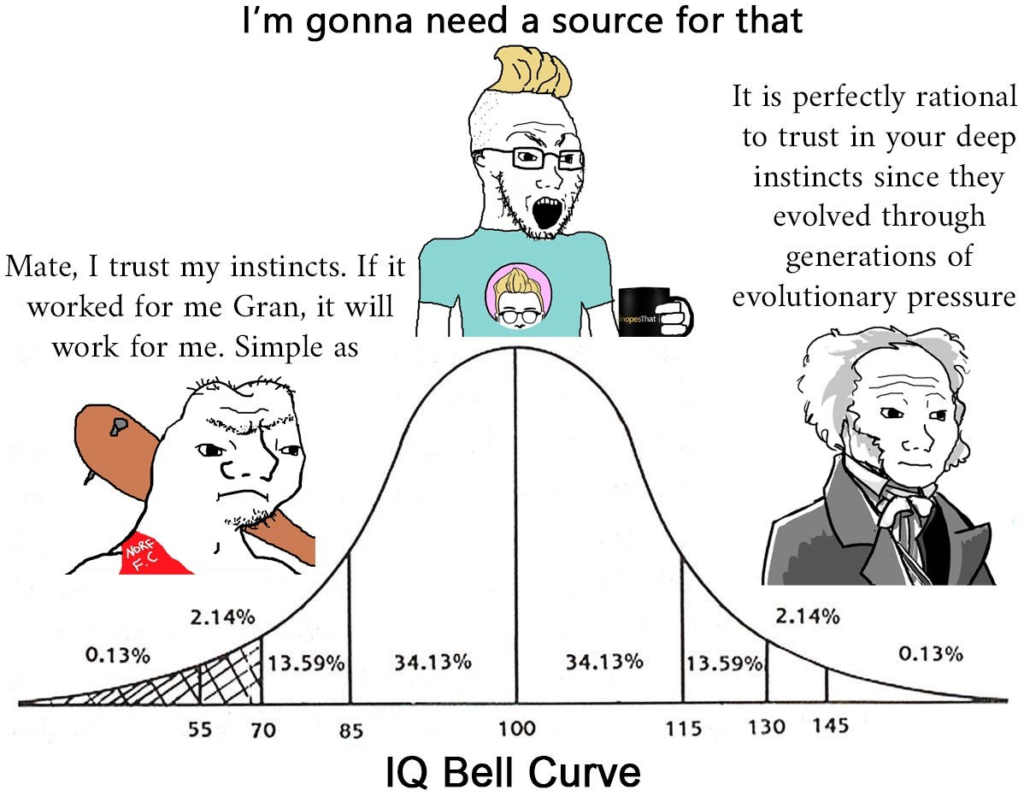One of my favorite memes —and also one of the most popular in recent years— is the bell curve meme with three characters. It’s known as the “midwit meme” or “IQ bell curve.” Let me walk you through it step by step.
Picture a bell-shaped curve. On top of it, you see three characters:
- On the left, “the dimwit”, a character with low IQ. He says something very simple, but accurate.
- In the center, “the midwit”, someone of average intelligence. He mocks the first one and gives a more complicated version of the same idea.
- On the right, “the genius”, the wise one. Often shown as a Jedi or philosopher. He says the same thing as the first one, but with calmness and confidence.

To better understand this meme, I want to explain the curve in it. It’s a “normal distribution,” also called a bell curve. In this case, it represents IQ. Here’s what it means:
- Very few people have a very low IQ (far left).
- Very few people have a very high IQ (far right).
- Most people are in the middle, with an average IQ.
The curve is higher in the middle because that’s where most people are.
The Dunning-Kruger Effect
I believe this meme helps us understand the well-known Dunning-Kruger effect. It’s a theory by psychologists David Dunning and Justin Kruger that explains something you’ve probably experienced yourself. Look:
- Stage one: You learn something new and get excited. You know more than before, so it feels like you understand everything. Everyone else seems clueless.
- Stage two: You keep learning and realize there’s way more than you thought. The amount of information overwhelms you and you start to doubt.
- Stage three: You get used to that complexity. You no longer think you’re better than others. You recognize your limits and respect other people’s knowledge.

What if it’s not a mistake?
Sometimes people think this curve shows how someone evolves over time. That’s not accurate.
But… what if we purposely decide to see it that way?
Let’s change what the axes mean:
- Horizontal axis: instead of IQ, now it represents time.
- Vertical axis: instead of number of people, it represents your frustration or inner tension.
Now, the curve becomes an emotional story. It resembles the Dunning-Kruger effect, but from the inside — from what you feel.
At the beginning, when you know nothing (“the dimwit”), you’re honest with yourself. You’re not frustrated because you have no big expectations. You’re just starting.
Then, you make an effort. You learn new things, you understand some ideas, you learn the jargon.
Since you’ve improved a lot, you feel like you know everything. You rise up the curve, confident. You’re not frustrated — in fact, you feel strong.
Until reality hits you.
What you learned doesn’t always work. You make mistakes. You see contradictions. Then, your frustration grows.
You feel deceived. You enter a phase of doubt, fatigue, and loss of confidence. This is where you are at the center of the curve: you’ve become the “midwit.”
This part is hard. Many give up here. Some call it “the valley of despair.”
But if you keep going, something changes.
It’s not that you reach a higher level — it’s that you start accepting things as they are. You stop fighting what you can’t control. You begin to flow.
That’s wisdom. Not because you know more, but because you understand when not to force things.
And this is where you return to the first character, “the dimwit,” but with one big difference: you’ve made the whole journey. You say simple things, but with a calmness and clarity that only come from experience.
Now what?
But on that journey… how do you choose which path to take? What tools do you have to explore your options?
Reading. Talking with people you consider wise. Reflecting. Meditating. All of that helps.
And when we’re talking about financial and lifestyle decisions, there’s one more tool: Financial Transurfing.
It’s a method for exploring possible futures and consciously choosing the direction you want to take — using logic, intuition, and a broader vision of the life you want to build.
Imagine your life as a huge map full of possible roads. Each decision opens a door, each doubt splits the path. Sometimes you don’t know where to go. Other times you feel it’s too late to change direction.
But it’s not.
Financial Transurfing helps with exactly that: exploring those routes as if you could step outside yourself and see the future from above.
It gives you clarity to choose the path that resonates most with you — and strength to stay on it.
Don’t get stuck in the role of the midwit. Be the dimwit, or be the genius — but don’t settle for the middle. The midwit gets tangled in doubt, frustration, and overthinking. He’s not happy. But you can move forward.
This meme isn’t just a joke. It’s a mirror. It reflects your inner path: it begins in innocence, gets tangled in effort and pride, and —if you don’t give up— ends, hopefully, in clarity.